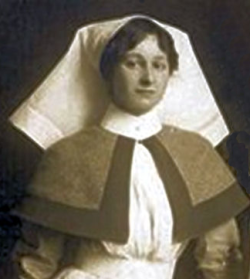CHANDLER, Dorothy Maud
Biography
Dorothy Maud Chandler was born in Epsom on 2nd January 1886[1] [2]. She contracted Rheumatic Fever as a child which damaged her heart[2]. She trained as a nurse at the Epsom Union Workhouse Infirmary, 1910-1914[2] [3]. She was accepted into the Queen Alexandra’s Imperial Military Nursing Service (Reserve) on the 14th January 1915[2].
Nursing Service in WW1
Most of her military service was at the Queen Alexandra Military Hospital, Millbank, London[2]. Between April and May of 1917 she was sent on temporary duty to France. First to 26 General Hospital and then to 1 BRC Hospital to learn about a new way of dealing with wounds, the Carrel-Dakin method. On 15th November 1917 she died of a cerebral embolism at the Hospital for QAIMNS Sisters, Vincent Square, London[2]. Her death was linked to a damaged mitral valve caused by the Rheumatic Fever she had as a child[2].
References
Note: A prominent French surgeon, Dr. Alexis Carrel, was working in a temporary field hospital and lab near the forest of Compiegne in France, just six and a half miles from the front. Carrel realized that the greatest surgical need was a better method of sterilising wounds, so he and English chemist Henry D. Dakin developed a system that would irrigate wounds with a sterilising solution – saving soldiers’ lives and limbs. Dakin developed the solution, while Carrel developed an apparatus to deliver it.

